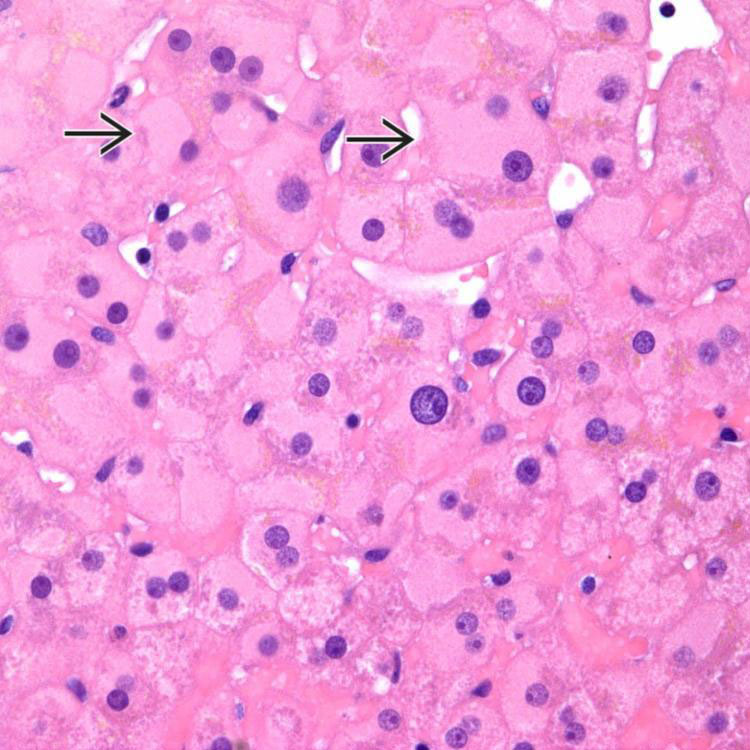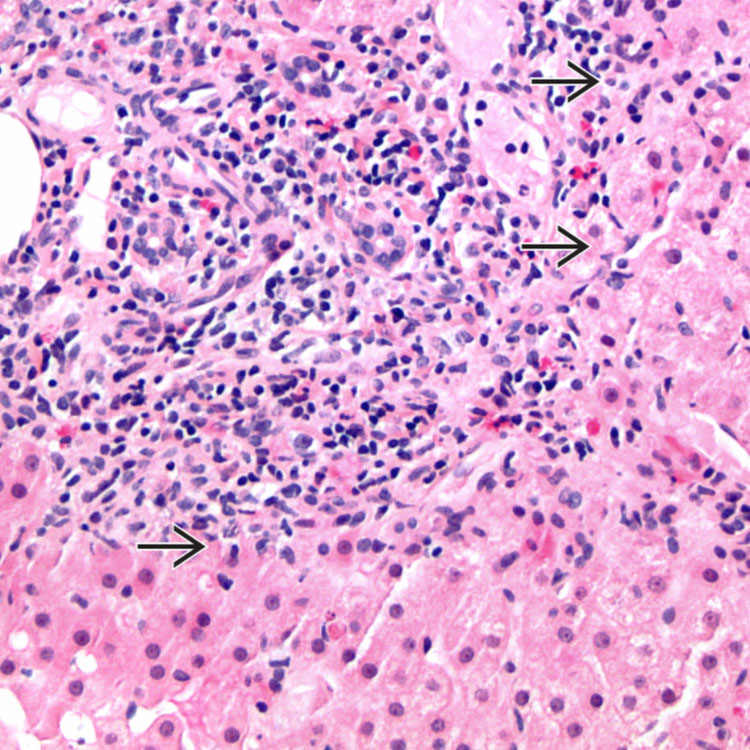Typically transmitted vertically, parenterally, or sexually
Clinical Issues
•
10% of infected patients become chronically infected

400 million people worldwide have chronic HBV
•
Symptoms include mild flu-like syndrome, nausea, vomiting, jaundice

> 50% are asymptomatic
•
Lifelong risk of developing cirrhosis &/or HCC
•
Useful laboratory tests include serology for HBV viral antigens, anti-HBV antibodies, and HBV DNA viral load
Microscopic
•
Acute hepatitis B

Hepatocytic swelling, predominantly lobular inflammation, spotty necrosis

Severe cases may show confluent and bridging necrosis, collapse of hepatocytic cords, hepatocytic regeneration
•
Chronic hepatitis B

Portal-based inflammation with variably present ground-glass hepatocytes, “sanded nuclei” in hepatocytes, variable fibrosis
–
Stage of fibrosis indicates disease progression and is important therapeutic and prognostic indicator
•
Immunohistochemistry for HBcAG and HBsAG may be useful, but not invariably positive
TERMINOLOGY
Abbreviations
•
Hepatitis B virus (HBV)
Synonyms
•
Australia antigen: Hepatitis B surface antigen (HBsAg)
Definitions
•
Infection by HBV

Member of Hepadnaviridae family

Genome comprises partially double-stranded DNA virus
ETIOLOGY/PATHOGENESIS
Infectious Agents
•
Transmitted parenterally

Vertical transmission: Mothers to newborn infants

Horizontal transmission: Between young children

Sexual contact
•
Liver injury appears to be immune mediated

HBV-specific T cells play key role in pathogenesis and viral clearance
CLINICAL ISSUES
Epidemiology
•
Incidence

400 million people worldwide are chronically infected with HBV
Presentation
•
Acute hepatitis B

Symptoms include mild flu-like symptoms, nausea, vomiting, jaundice

< 1% develop fulminant liver failure leading to death or liver transplantation

Serum HBsAg and anti-HBc virus IgM Ab positive
•
Chronic hepatitis B

Serum HBsAg positive and anti-HBc virus IgM Ab negative
Laboratory Tests
•
Serology for HBV viral antigens: HBsAg, HBcAg, HBeAg
•
Serology for anti-HBV antibodies: Anti-HBs, anti-HBc, anti-HBe
•
Serum HBV DNA and viral load
Natural History
•
10% of infected individuals become chronically infected
•
Life-long risk of developing cirrhosis &/or HCC in chronic hepatitis B

Cirrhosis is not prerequisite for developing HCC
–
HBV viral genome can act as oncoprotein and intergrade into host genome
Related
Diagnostic Pathology Hepatobiliary and Pancreas

 have glassy eosinophilic cytoplasm representing proliferation of smooth ER in response to HBsAg.
have glassy eosinophilic cytoplasm representing proliferation of smooth ER in response to HBsAg.
 ) representing nuclear accumulation of HBcAg. These may be hard to detect on routine H&E staining.
) representing nuclear accumulation of HBcAg. These may be hard to detect on routine H&E staining.








 into the periportal parenchyma.
into the periportal parenchyma.











